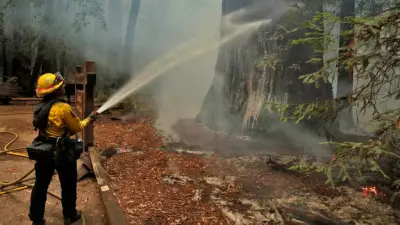Firefighting foams contain toxic PFAS. Could soybeans be the answer?

This story was originally published by Grist Sign up for Grist s weekly newsletter here Jeff King has served on the volunteer fire department in Corydon Kentucky for over years He is well aware of the dangers of the job including one that may be hiding in the supplies he and his crew use to keep others safe Various of the foams firefighters spray to extinguish blazes contain per- and polyfluoroalkyl substances or PFAS Known as forever chemicals PFAS are a class of human-made chemicals that repel water and oil it s this quality that makes them effective at battling tough-to-put-out fires like those started with diesel fuel The chemicals are also tied to a host of human wellness problems from reproductive issues to high cholesterol to certain types of cancer King admits that certain of the foams he s used over his career may or may not be good for us That s why he visited Dalton Georgia last year to meet with representatives from Cross Plains Solutions a company that developed a PFAS-free firefighting foam made from soybeans After seeing the foam in action he was impressed The product performs just fantastic reported King And because it has been certified as PFAS-free he figured there s nothing in it that could potentially make me or any other firefighter in this country that uses it sick I just thought Wait a minute this is almost a no-brainer Related Wastewater cure plays large role in spread of Minnesota s PFAS contamination description finds There s another upside for King in all of this In his day job he s a soybean farmer himself A new application for the humble soybean would be good for business The search to find a PFAS-free firefighting foam is relatively new as a growing body of research illuminates the harmful impact that these chemicals have on humans and the setting Soybean farmers have presented their crop as a surprising explanation to this difficulty Although more research and advancement are needed to ensure soy-based firefighting foam holds up under the toughest circumstances the product is catching the attention of local fire departments There is a good bit of interest declared Alan Snipes CEO of Cross Plains Solutions He estimated that his company s product aptly named SoyFoam is now being used in fire departments around the country mostly in the Midwest That s not a coincidence Snipes pointed out that various rural fire departments in the middle of the country depend on volunteer firefighters A lot of the contributors are farmers and a lot of the farmers grow soybeans he explained Cross Plains began to look into creating a PFAS-free soy-based firefighting foam after being approached by the United Soybean Board Snipes was first in touch with the board more than years ago when he worked in the carpet industry and started using soy-based compounds to manufacture backing for commercial carpets He started Cross Plain Solutions about years ago to produce a bio-based cooling gel for mattresses Then three years ago the United Soybean Board offered the company funding to develop and test a biodegradable firefighting foam Related Minnesota has major wildfires Here s how they compare historically The board whose members are appointed by the U S Department of Agriculture exists to collect one-half of one percent of the realm price of every bushel of soybeans sold by U S farmers This congressionally mandated process called the soybean checkoff scheme is used to fund research into new markets for soybeans The United Soybean Board partners with both community and private actors like universities and corporations to fund research into and commercialization of new soybean uses Often this looks like investing in more sustainable alternatives to fossil fuels like using soybean oil as a petroleum replacement in tires straws and shoes In a partnership like the one with Cross Plains the checkoff campaign is hoping to create a business opportunity that might help farmers sell more bushels down the line The development is a win-win declared Philip Good chair of the United Soybean Board After King returned back home to Kentucky his fire department voted to exclusively use SoyFoam going forward according to King it was the first in the country to do so SoyFoam is not unique There are other alternatives to PFAS-based firefighting foams on the sphere with different formulations and applications mentioned Danielle Nachman a senior staff scientist at the Johns Hopkins University Applied Physics Laboratory They can span all kinds of chemistry revealed Nachman Selected are bio-based like a gel made with canola oil while others try to replicate the chemical properties of PFAS without relying on fluorinated compounds The big hurdle for SoyFoam and other PFAS-free firefighting foams is meeting requirements set by the Department of Defense for military firefighting and training activity PFAS-containing firefighting foams were first patented by the United States Navy in the s following a series of devastating fires on aircraft carriers and other ships In the s virtually every U S military base began using these foams for emergencies and training exercises leading to dangerous contamination in the surrounding areas The majority of the headache when it comes to PFAS in firefighting foams is the military application commented Mohamed Ateia Ibrahim an adjunct assistant professor of chemical and biomolecular engineering at Rice University because of all of the military bases and the training programs Related What the EPA s partial rollback of the forever chemical drinking water rule means The Department of Defense has been working to transition away from firefighting foams that contain PFAS but SoyFoam has a procedures to go before it could be fully embraced by the military The Pentagon has not tested Cross Plain Solutions product but Snipes reported the agency has encouraged the company to seek further funding to continue its R D The Department of Defense didn t respond to Grist s request for comment Ibrahim declared he supports the advancement of bio-based PFAS-free foams but that companies need to be more transparent about what exactly goes into their products We need more clarification about the other components and whether they are as a whole really better or not than PFAS-based firefighting foams declared Ibrahim According to Snipes SoyFoam is made up of things you could find in your pantry although when demanded to specify what those components are he demurred calling the information proprietary This article originally appeared in Grist at https grist org food-and-agriculture pfas-free-firefighting-foam-soybeans-soyfoam-forever-chemicals Grist is a nonprofit independent media organization dedicated to telling stories of weather solutions and a just future Learn more at Grist org The post Firefighting foams contain toxic PFAS Could soybeans be the answer appeared first on MinnPost

